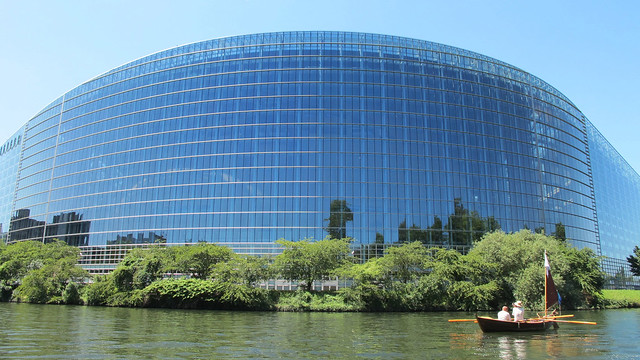
We left our story in Vendenheim, with Henri Bronner, the Mayor. His generosity is fantastic: The next day he takes us out for lunch. Here, anyone is very kind and cares about us, as happened everywhere so far in our journey.
Sincerely! Maybe also because they know that we’re just in transit, and being light is really helpful in life. The weight of a long-term commitment on protecting standing properties and little conforts, can make us a bit more selfish and less open-minded.
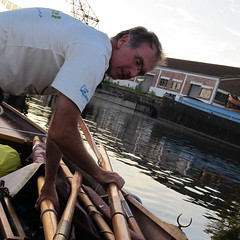 On the opposite, the uncertainty of travelling forces us to look at the world with new eyes, so other people reflect themselves in what you do and what you feel.
On the opposite, the uncertainty of travelling forces us to look at the world with new eyes, so other people reflect themselves in what you do and what you feel.
It’s a matter of water… resonances, as stated by Masaru Emoto, a controversial Japanese scholar considered a guru by many and a charlatan by the most part of scientists. I must admit that I appreciate many of the things that he says, by direct experience. In life, metaphysics is much closer to real physic of what we think.
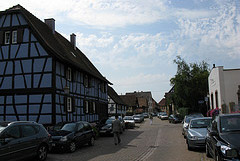 We enjoy a good sleep moored side by side to Rataka, the housboat of Remy and Nadash. At 6 o’clock I neak out to find bread and croissants for Fine, Bruno and me, finding a nice boulangerie in the heart of Vendenheim. At noon, the mayor picks us up for lunch, along with his wife and daughter in law (his son works in Boulogne sur Mer, surveilling the English Channel).
We enjoy a good sleep moored side by side to Rataka, the housboat of Remy and Nadash. At 6 o’clock I neak out to find bread and croissants for Fine, Bruno and me, finding a nice boulangerie in the heart of Vendenheim. At noon, the mayor picks us up for lunch, along with his wife and daughter in law (his son works in Boulogne sur Mer, surveilling the English Channel).
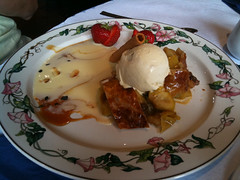 Alsatian cuisine is rich and interesting, too tasty to waste any time in describing it: I have to concentrate on eating like a pig! My dish resembles a bit a Piedmontese recipe, brasato al Barolo, made of savoury meats and French sauces. Fine and Bruno have sauerkrauts and potatoes, with sausages, würstels and well-cooked pork, quite tasty indeed.
Alsatian cuisine is rich and interesting, too tasty to waste any time in describing it: I have to concentrate on eating like a pig! My dish resembles a bit a Piedmontese recipe, brasato al Barolo, made of savoury meats and French sauces. Fine and Bruno have sauerkrauts and potatoes, with sausages, würstels and well-cooked pork, quite tasty indeed.
I strive to be as vegetarian as I can, but it’s a very difficult task here.
In the evening we get invited for a party organised by the council workers of vendenheim, where we’re waited by another huge feast, lots of meat and worderful home-made cakes. We’re overwhelmed by people warmth. Henri, being the gentleman he is, publicly introduces us to the audience and we get plenty of applauses for our endeavour.
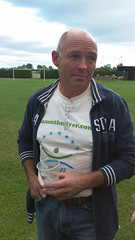 In the meantime we’ve been reached by a much appreciated guest, Karl (Kalle) Fine’s dad, just arrived from Hannover to stay a few days with us.
In the meantime we’ve been reached by a much appreciated guest, Karl (Kalle) Fine’s dad, just arrived from Hannover to stay a few days with us.
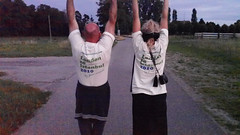 Kalle, nice and strong, has a wonderful job: He works on landscape art, building fabulous and poetical fences and many other objects by using willow timber and other materials that nature has to offer. In the evening we take a walk to Vendenheim, passing maize fields and big cherry trees.
Kalle, nice and strong, has a wonderful job: He works on landscape art, building fabulous and poetical fences and many other objects by using willow timber and other materials that nature has to offer. In the evening we take a walk to Vendenheim, passing maize fields and big cherry trees.
The next morning we stand for a few photos taken by local journalists, with Henri aboard Clodia. Then, aftere a brief goodbye to Nadash, we leave to Strasbourg. We row once again!
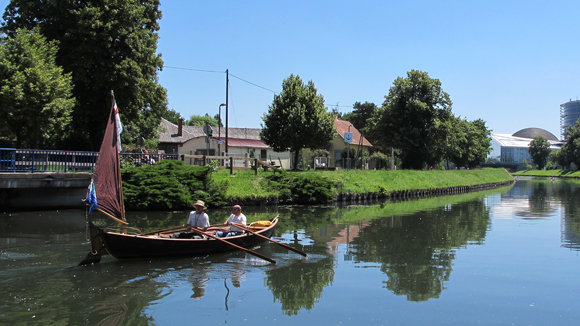
A mediterranean heat surrounds us. It might be that, or the conversation about the “big picture” with Kalle who is aboard with me, or even still the greetings from a couple of fishermen, but below the last bridge before Strasbourg, after having passed about 700 others, I hear Clodia slowing down, then a nasty craaaaackkkkk…
I turn back and I see Kalle bent, eyes wide open, keeping in his hand the main mast, that’s falling over me. Damn… I swear, cursing myself: I can’t believe it. It was just me, praying for attention everytime, that got distracted! I’m thinking already to the damages to be fixed…
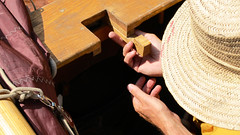 Thanksfully the main traveller of Clodia and the mast lock was wisely built by Roland in such a way to break immediately, avoiding further damages to the structure to the hull in cause of collision with a bridge.
Thanksfully the main traveller of Clodia and the mast lock was wisely built by Roland in such a way to break immediately, avoiding further damages to the structure to the hull in cause of collision with a bridge.
Everything worked but unfortunately the base of the mast broke the watertight bulkhead at stem, that’ll be harder to repair. The mast, however, is untouched. “Manco mal”… As they say in Venice (meaning “not as bad as it could have been”, “luckily”).
Archived this accident, we set off again in a very low-spirit. Nature comes to our help, through a centuries-old cherry tree that Bruno climbs like a monkey. I follow him in a much clumsier fashion and take comfort by the sweetest black cherries tasted so far.
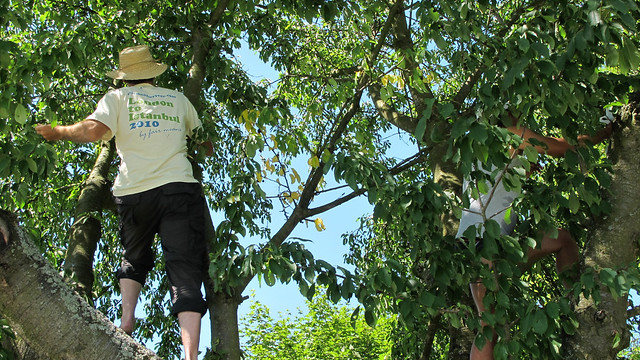
We’re on the edge of Strasbourg and the last lock, number 51, marks our farewell to the French Canals. We’ve passed 252 locks (not to mention 20 on the Thames): One by one they’re quite a lot. We’re waited by about one hundred more on the way to Istanbul, maybe a little less.
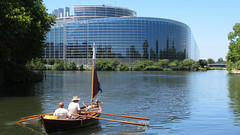 We enter Strasbourg at 2 a’clock of a sticky hot sunday, over 33°C of temperature. We row in front of the European Parliament and its technological show-off: I have to think about all the money that many members of the parliament earn (an Italian member could receive as much as 35.000 EURO per month) while so many people, often more capable, struggle with very low wages. Efficient politicians do exist, but they’re rare birds. I wonder why.
We enter Strasbourg at 2 a’clock of a sticky hot sunday, over 33°C of temperature. We row in front of the European Parliament and its technological show-off: I have to think about all the money that many members of the parliament earn (an Italian member could receive as much as 35.000 EURO per month) while so many people, often more capable, struggle with very low wages. Efficient politicians do exist, but they’re rare birds. I wonder why.
We stop for a quick lunch in a small kiosk, run by a very kind armanian-russian man. Just the time to learn that I’m Italian, and he loads a compilation of hits of the 70′s, 80′s and 90′s, as loud as ever, with Adriano Celentano (a very very popular singer and showman) as undisputed emperor.
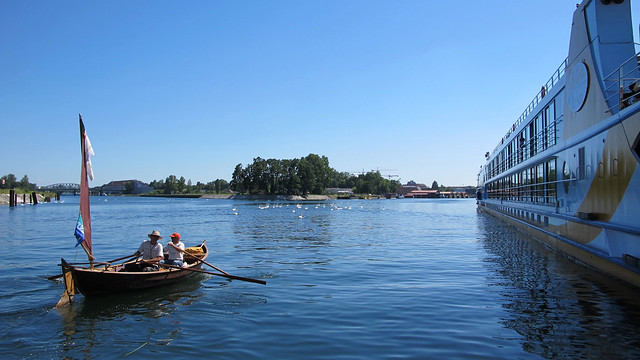
It wasn’t for a few details, I could as well be rowing along the Ticino river in Italy. The nice, transparent water, reminds me of that found there on my previous journey, after 400 km of thick yellow waters along the Po river. The wind has risen: It’s time to leave and Kalle is still on my side. Eventually, we find high bridges and the huge ferries makes us understand that we’re very close to the Rhine.
Strasbourg harbour is large, but we’ll cross even larger ones along the way. Bruno and Fine mood Serena on the shadow of big plane trees along the canal, while I get going, looking for a quieter place to dock. In the distance, I spot a woman waving her hands, aboard a Peniche.
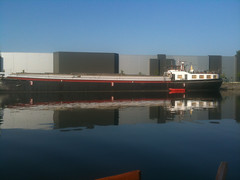 When I get close, she shows me a copy of the DNA (Derniere Nouvelles Alsaciennes), a newspaper with an article written about us and a nice picture of Clodia. Her boat is called Labor and is very big, 55 by 6 mt.: Anne, smiling, kindly invites me to jump aboard for a coffee. How nice, I’m happy to accept. To get on board I have to climb about 3 metres: Much different scales compared with those Peniche on the canals.
When I get close, she shows me a copy of the DNA (Derniere Nouvelles Alsaciennes), a newspaper with an article written about us and a nice picture of Clodia. Her boat is called Labor and is very big, 55 by 6 mt.: Anne, smiling, kindly invites me to jump aboard for a coffee. How nice, I’m happy to accept. To get on board I have to climb about 3 metres: Much different scales compared with those Peniche on the canals.
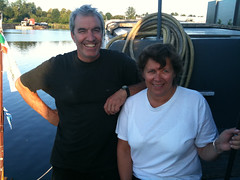 There, I discover a wonderful house and meet Toni, Anne’s partner, who welcomes me. I enjoy a nice coffee and an even nicer conversation with my hosts. Anne and Toni’s business is about culture and their peniche is a huge atelier.
There, I discover a wonderful house and meet Toni, Anne’s partner, who welcomes me. I enjoy a nice coffee and an even nicer conversation with my hosts. Anne and Toni’s business is about culture and their peniche is a huge atelier.
They’ve plenty of ideas and sponsor lots of initiatives, such as a Boat Festival in 2010 and a Christmas Market on water, attracting visitors from all around the world.
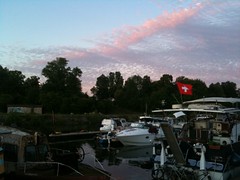 The “liveaboard” community is quite large and quickly welcomes me. The little harbour is pleasant and protected, close to the citadel. As always, we’ll get generously offered free mooring for the two days of stay with Clodia.
The “liveaboard” community is quite large and quickly welcomes me. The little harbour is pleasant and protected, close to the citadel. As always, we’ll get generously offered free mooring for the two days of stay with Clodia.
Another nice lady, Helene, invites me for dinner after a long chat aboard Serena: In the meanwhile Josephine, Kalle and Bruno get to sleep rather early.
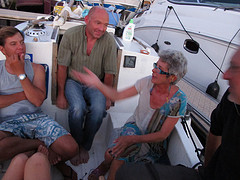 Helene, a theatrical costumes designer, is a charming woman living aboard by six years: unfortunately her beautiful steel boat, dating 1908, has sunk for unknown reasons.
Helene, a theatrical costumes designer, is a charming woman living aboard by six years: unfortunately her beautiful steel boat, dating 1908, has sunk for unknown reasons.
Helene’s life was tough and now the dispute with the insurance make her suffer even more. It’s not all a bed of roses for liveaboards. I take a good shower (much appreciated…) then I get to sleep under the stars, since it doesn’t look like raining.
In the morning, I wake up with two black eyes closely staring at me. A very long neck: A curious swan enjoys the show, then it moves on, looking for something tastier for breakfast.
 Our day will be as full as usual: We’re waited by many interviews and fixings on Clodia. Yesterday Bruno took care of the most of it however the bulkead has still to be repaired.
Our day will be as full as usual: We’re waited by many interviews and fixings on Clodia. Yesterday Bruno took care of the most of it however the bulkead has still to be repaired.
We need resin and other stuff, not to mention food. I travel in an unusual, disturbing heat, and the traffic noise in not here to help. Eventually we sort it all out, then, gasping, we meet in the harbour.
 I try to sleep a little in the shadow of a boat, but a woman comes to tell me her interesting story aboard the Glass Boat belonging to Alexandre, master glassmaker. How nice these tales of people that, regardless of age, build a new life. Alexander for instance was a truck driver, but when he turned 50 he decided to change.
I try to sleep a little in the shadow of a boat, but a woman comes to tell me her interesting story aboard the Glass Boat belonging to Alexandre, master glassmaker. How nice these tales of people that, regardless of age, build a new life. Alexander for instance was a truck driver, but when he turned 50 he decided to change.
Thinking of it, it’s my story too. How hard, and what a beautiful life I found. Someone said that the way to poverty is quite easy, and I’m not talking just about money. To have something more you have to do something more. A lot more. I don’t sleep but I learn, it’s better. I can sleep later on.
At 5.30 p.m. we have an interview with Madame Buchmann (remember?) who is in charge of ecology and we get invited to the Strasbourg city council. We enter with Bruno after a nice walk along the river, being welcomed by an elegant Gentleman who says: “Are you the rowers?”. “Yes, Sir!” and he takes us to Ms Buchmann office. We learn that she mentioned our journey in the last council meeting. What an honour!
 Even inside, the heat is terrible and our “political” day gets quite tiring, however still full of energy and passion. The interview is interesting and intense: We discover the environmental strategies of Strasbourg and I get the impression that Ms Buchmann is a truly passionate and dedicated administrator. Please come to Strasbourg to take a look.
Even inside, the heat is terrible and our “political” day gets quite tiring, however still full of energy and passion. The interview is interesting and intense: We discover the environmental strategies of Strasbourg and I get the impression that Ms Buchmann is a truly passionate and dedicated administrator. Please come to Strasbourg to take a look.
Then, back to Anne and Toni‘s boat for a new interview and finally a bit of tourism, visiting the city. Canals, wood and bricks buildings, nature and art live together in the small as in the large scale. The steeple of the chatedral is really awsome, breathtaking flamboiant gothic.
It’s time to jump on the boat for a good sleep. The next morning we’re waited by the Rhine and a new chapter is ready to be written. A real big river, after the Thames and the Moselle.

We’re excited and happy, tomorrow we’ll celebrate our first 1000 km: 1000 km of joy and struggle, meetings and gifts, but overall of waters across Europe. The veins and the arteries of this big continent. We’re within and over them, trying to do as little damage as possible and to learn.
See you soon, my friends.

 Our Alsatian adventure begun in the Vosges: Language, architecture, flavours had changed. However, at this stage I was really convinced to have landed to Germany, but I’m still in France. So what can we say?
Our Alsatian adventure begun in the Vosges: Language, architecture, flavours had changed. However, at this stage I was really convinced to have landed to Germany, but I’m still in France. So what can we say? That’s Europe and I’m becoming ever more convinced that the borders were drawn by people either crazy or drunk.
That’s Europe and I’m becoming ever more convinced that the borders were drawn by people either crazy or drunk.
 So far the waves are keeping low, we face an opposite yet weak wind and the big barges are fast enough (about 20 Km/h) but very open-eyed on us as we’re on them.
So far the waves are keeping low, we face an opposite yet weak wind and the big barges are fast enough (about 20 Km/h) but very open-eyed on us as we’re on them.
 We look like a mice in an elephant dance party, but these elephants know how to spin.
We look like a mice in an elephant dance party, but these elephants know how to spin.
 We stopped for two days in Saverne, lovely city, where we’ve been invited for a pizza on the holyday-boat of a nice German couple, Volker and Ilka. Their pizza was beautiful such as their hospitality aboard Grønland, a Dutch Tijalk (a flat bottomed boat) that they’ve completely restored.
We stopped for two days in Saverne, lovely city, where we’ve been invited for a pizza on the holyday-boat of a nice German couple, Volker and Ilka. Their pizza was beautiful such as their hospitality aboard Grønland, a Dutch Tijalk (a flat bottomed boat) that they’ve completely restored.  The morning after, Bruno takes Volker aboard Clodia for a sail in the basin facing the wonderful 17th century palace, the Chateau of Saverne, whose majesty has earned it the name “Versailles Alsace“.
The morning after, Bruno takes Volker aboard Clodia for a sail in the basin facing the wonderful 17th century palace, the Chateau of Saverne, whose majesty has earned it the name “Versailles Alsace“.
 To reach the city we have to cross as much as 4 waterways in 1 km, a sort of word record!
To reach the city we have to cross as much as 4 waterways in 1 km, a sort of word record!
 On the walls we see strange paintings of people looking out of the window, and ground signs telling manholes may be used as dog toilets. These clues lead to a conclusion: French mind-set has never worked very well here. After all the majority of surnames is German and everyone is bilingual, since Alsace was Germany for a long time.
On the walls we see strange paintings of people looking out of the window, and ground signs telling manholes may be used as dog toilets. These clues lead to a conclusion: French mind-set has never worked very well here. After all the majority of surnames is German and everyone is bilingual, since Alsace was Germany for a long time. The fist is called Henri Bronner, mayor of Vendenheim and friend of Guy Rougieux. He’s so kind to come to pick us up at 9 o’clock in the morning in Hochfelden, displaying Alsatian punctuality (5 to 7 minutes away from that of Germany, which in turn follows by 5 minutes the Swiss one, unchallenged even by Japanese).
The fist is called Henri Bronner, mayor of Vendenheim and friend of Guy Rougieux. He’s so kind to come to pick us up at 9 o’clock in the morning in Hochfelden, displaying Alsatian punctuality (5 to 7 minutes away from that of Germany, which in turn follows by 5 minutes the Swiss one, unchallenged even by Japanese). Dr Samir Idir shows to Fine and me this technological marvel that gives back water to the big river, who’s seriously ill and therefore under strict observation by the European Community.
Dr Samir Idir shows to Fine and me this technological marvel that gives back water to the big river, who’s seriously ill and therefore under strict observation by the European Community. The left-overs of depuration are used to produce natural gas, in such an extent that from next year the plant will be self-sufficient for heat energy and really soon for electricity too (they’re even planning to sell the energy surplus).
The left-overs of depuration are used to produce natural gas, in such an extent that from next year the plant will be self-sufficient for heat energy and really soon for electricity too (they’re even planning to sell the energy surplus). Later on, we are introduced to
Later on, we are introduced to  We then go to Vendenheim, where we visit the city hall, an enviable Senior Citizens’ Centre and a sport centre built by using the latest and best energy saving technologies. A dream made real.
We then go to Vendenheim, where we visit the city hall, an enviable Senior Citizens’ Centre and a sport centre built by using the latest and best energy saving technologies. A dream made real. To get back to Hochfelden, where Clodia is moored, we get a lift from Damien, a policeman from Vendenheim.
To get back to Hochfelden, where Clodia is moored, we get a lift from Damien, a policeman from Vendenheim. Bruno (who stayed to look after the boat) is impatiently waiting for us, because the wind is strong enough to set sails. We get going very quickly, with Bruno at the tiller and Fine rowing, covering 18 km in 5 hours: Just in time to arrive to Vendenheim where we stop for two days, shaded by a wonderful Dutch boat.
Bruno (who stayed to look after the boat) is impatiently waiting for us, because the wind is strong enough to set sails. We get going very quickly, with Bruno at the tiller and Fine rowing, covering 18 km in 5 hours: Just in time to arrive to Vendenheim where we stop for two days, shaded by a wonderful Dutch boat. It’s the house of Remy, lock-keeper of the first “ecluse” on the Rhine after Strasbourg. Remy and his wife Nadash, a bycicle postwoman, offer us a hot shower and a tasty dinner, where we’re entertained by stories about the lock and the big river. Their daughter Marine even draws a lovely picture of us that you can see below!
It’s the house of Remy, lock-keeper of the first “ecluse” on the Rhine after Strasbourg. Remy and his wife Nadash, a bycicle postwoman, offer us a hot shower and a tasty dinner, where we’re entertained by stories about the lock and the big river. Their daughter Marine even draws a lovely picture of us that you can see below!

 We left our story in the outskirts of Nancy: At first glance I really liked this city. I can now confirm and reinforce the enthusiasm for a community that seems very committed in preserving the environment and offering a good lifestyle to all its citizens, beginning from the means of moving.
We left our story in the outskirts of Nancy: At first glance I really liked this city. I can now confirm and reinforce the enthusiasm for a community that seems very committed in preserving the environment and offering a good lifestyle to all its citizens, beginning from the means of moving. The network of public transport is well-distributed and the electric tram reaches most of the suburbs. Methane fueled buses and a well managed traffic make of Nancy a very clean and pleasant city. We’re welcomed by Sylvain, who works and studies here. He speaks a good English, however we strive to speak French.
The network of public transport is well-distributed and the electric tram reaches most of the suburbs. Methane fueled buses and a well managed traffic make of Nancy a very clean and pleasant city. We’re welcomed by Sylvain, who works and studies here. He speaks a good English, however we strive to speak French.  His hospitality and help have revealed priceless, beginning from
His hospitality and help have revealed priceless, beginning from  Thomas also organises events and tours, and the lab in rue des Tiercelins 18, can be freely used by all members to fix their bikes. A good idea worth to be followed.
Thomas also organises events and tours, and the lab in rue des Tiercelins 18, can be freely used by all members to fix their bikes. A good idea worth to be followed. The next day Paul takes us to meet his uncle Guy Rougieux, president of the syndicate of waters from the Seille and Moselle rivers. Guy has spent many years working on the water-supply system for the villages around Nancy. We follow him in a plateau housing a very interesting network: Here we visit a central where chlorine is added to drinking water by law, following the events of 2001 and the fear for terrorist attacks.
The next day Paul takes us to meet his uncle Guy Rougieux, president of the syndicate of waters from the Seille and Moselle rivers. Guy has spent many years working on the water-supply system for the villages around Nancy. We follow him in a plateau housing a very interesting network: Here we visit a central where chlorine is added to drinking water by law, following the events of 2001 and the fear for terrorist attacks. 
 Guy’s help is precious and will be even more important very soon: We develop a very strong friendship. In the evening we’re invited for dinner in his home in Lanfroincourt, 130 inhabitants, where we also visit La Pepiniere (the plant-nursery) of Etienne, Paul’s dad, and pick the same cherries used to make Paul’s mum’s jam. Paul tells us about the current hard times for quality plant-nurseries in Lorraine, after the invasion of low-cost plants.
Guy’s help is precious and will be even more important very soon: We develop a very strong friendship. In the evening we’re invited for dinner in his home in Lanfroincourt, 130 inhabitants, where we also visit La Pepiniere (the plant-nursery) of Etienne, Paul’s dad, and pick the same cherries used to make Paul’s mum’s jam. Paul tells us about the current hard times for quality plant-nurseries in Lorraine, after the invasion of low-cost plants. The dinner cooked by René, the nice wife of Guy, is special, full of delicious Lorraine specialties such as the Pâté Lorrain and the classic Quiche Lorraine. In the end Guy gives us a Mirabelle Brandy and René some magic cherries.
The dinner cooked by René, the nice wife of Guy, is special, full of delicious Lorraine specialties such as the Pâté Lorrain and the classic Quiche Lorraine. In the end Guy gives us a Mirabelle Brandy and René some magic cherries. The morning after, in the Port de Plaisance of Nancy we meet the director, Captain Franck Rosseaux, who tells us about this showpiece harbour and his commitment to protect the environment through initiatives aimed to reduce the waste of water and the leakage of bilge water and greywater (collecting them for free).
The morning after, in the Port de Plaisance of Nancy we meet the director, Captain Franck Rosseaux, who tells us about this showpiece harbour and his commitment to protect the environment through initiatives aimed to reduce the waste of water and the leakage of bilge water and greywater (collecting them for free).
 In Varangeville, site of the famous salt mines, despite the heavy rain I approach a Peniche showing my best smile and asking for a good coffee shop.
In Varangeville, site of the famous salt mines, despite the heavy rain I approach a Peniche showing my best smile and asking for a good coffee shop. Quite soon, in the usual cozy and warm way of people who live aboard, we get feed with a substantial breakfast and guided for a tour of Saint Nicolas de Port.
Quite soon, in the usual cozy and warm way of people who live aboard, we get feed with a substantial breakfast and guided for a tour of Saint Nicolas de Port. Anouk and her husband Dany also makes us dinner and we get overwhelmed by their warmth and friendliness. We have a wonderful time: Thanks Anouk and Dany, you gave us a special day to remember. The next morning the sun pops out and we get moving greeting our hosts with the usual sadness.
Anouk and her husband Dany also makes us dinner and we get overwhelmed by their warmth and friendliness. We have a wonderful time: Thanks Anouk and Dany, you gave us a special day to remember. The next morning the sun pops out and we get moving greeting our hosts with the usual sadness. She tells us the story of the town of Dombasle and its abandoned harbour, victim of the obtuseness of politics and of the vandals that have wasted a structure that could have been of great help for this area. Here there is a Solvay big industrial plant, who might have limited the long term view of the governants.
She tells us the story of the town of Dombasle and its abandoned harbour, victim of the obtuseness of politics and of the vandals that have wasted a structure that could have been of great help for this area. Here there is a Solvay big industrial plant, who might have limited the long term view of the governants. After Dombasle, Clodia, Bruno and me enjoy exhilarating sails under a continuous rain followed by moments of sunshine: It’s a very Atlantic looking weather with sudden changes. In Lagarde we sleep in a lovely harbour, passing the evening in conversation about life.
After Dombasle, Clodia, Bruno and me enjoy exhilarating sails under a continuous rain followed by moments of sunshine: It’s a very Atlantic looking weather with sudden changes. In Lagarde we sleep in a lovely harbour, passing the evening in conversation about life. After a great sail helped by 40 km/h windblasts, we reach and pass the lock of Richecourt, who was for many years the highest French lock, from its 15.4 metres of height.
After a great sail helped by 40 km/h windblasts, we reach and pass the lock of Richecourt, who was for many years the highest French lock, from its 15.4 metres of height. But never say never. The next day two friendly employed from VNF, our notorious guardian angels, after hearing me whining against the refuse coming from Strasbourg headquarter, decide to go to Nederviller by boat. They’ll try to plead the cause of our humble oar’s crusade in the local VNF office: Not an easy task.
But never say never. The next day two friendly employed from VNF, our notorious guardian angels, after hearing me whining against the refuse coming from Strasbourg headquarter, decide to go to Nederviller by boat. They’ll try to plead the cause of our humble oar’s crusade in the local VNF office: Not an easy task. When they come back the no becomes a yes, assuming to get towed by an engine boat. Giving that the total distance to be covered is no longer than 6 km, we’re happy to accept this offer: Moreover any other means of transport would have been very hard to arrange and against our philosophy. So little Serena tows us.
When they come back the no becomes a yes, assuming to get towed by an engine boat. Giving that the total distance to be covered is no longer than 6 km, we’re happy to accept this offer: Moreover any other means of transport would have been very hard to arrange and against our philosophy. So little Serena tows us. After Saint-Louis Arzviller we enter a completely different world: Beech and coniferous forests, red rocks, castles, german architecture, a steep descent to Strasbourg. We’re in the Vosges.
After Saint-Louis Arzviller we enter a completely different world: Beech and coniferous forests, red rocks, castles, german architecture, a steep descent to Strasbourg. We’re in the Vosges. But I’m safe, it’s Guy who carries good news: He’s sold his soul to give us some interesting contacts in Strasbourg, where he has worked for many years and knows lots of people. He already arranged us a meeting with the mayor of a village who will be of great help. Guy is a saint who gave us help and passion. We’re touched, thanks.
But I’m safe, it’s Guy who carries good news: He’s sold his soul to give us some interesting contacts in Strasbourg, where he has worked for many years and knows lots of people. He already arranged us a meeting with the mayor of a village who will be of great help. Guy is a saint who gave us help and passion. We’re touched, thanks. Our journey so far has seen 200 locks, 8 tunnels, 13 suspended canals and we’re approaching the milestone of 1000 km, about 1/5th of the total itinerary.
Our journey so far has seen 200 locks, 8 tunnels, 13 suspended canals and we’re approaching the milestone of 1000 km, about 1/5th of the total itinerary.
 The mood is high and the bones wet. But water is life and local beer is also very tasty. We’re in Alsace, by the way, and wines are excellent too! In short, cheer up to fluids.
The mood is high and the bones wet. But water is life and local beer is also very tasty. We’re in Alsace, by the way, and wines are excellent too! In short, cheer up to fluids.
 There are the wild landscapes of the Marne side-canal, postcard-worthy. Herd of cattle running away at our approach, shaking the earth under their feet. And water, of course. We drink it straight from the canal: It’s potable and transparent down to 4 metres.
There are the wild landscapes of the Marne side-canal, postcard-worthy. Herd of cattle running away at our approach, shaking the earth under their feet. And water, of course. We drink it straight from the canal: It’s potable and transparent down to 4 metres. There are breakfasts in the midst of the steam rising from the canals, rain-wet nights, burnt days, opposite winds, handshakes from calloused hands, honest and warm hands. Kisses thrown in the air by a Turkish kid that keeps greeting us from the distance, so happy to read that word… Istanbul!
There are breakfasts in the midst of the steam rising from the canals, rain-wet nights, burnt days, opposite winds, handshakes from calloused hands, honest and warm hands. Kisses thrown in the air by a Turkish kid that keeps greeting us from the distance, so happy to read that word… Istanbul!
 There’s the old hearth of
There’s the old hearth of  Such as Chantal in Treveray, that takes me to join the rest of the crew (I was left behind to update the website, and a long walk was in front of me), and the Mayor of Treveray who helps me to send an important e-mail to the italian radio;
Such as Chantal in Treveray, that takes me to join the rest of the crew (I was left behind to update the website, and a long walk was in front of me), and the Mayor of Treveray who helps me to send an important e-mail to the italian radio; And Jean, an “eclusier” (lock-keeper), a profession that’s quickly disappearing due to the automations required by the cost-cuts. He invites us in his home, offering Champagne, along with his charming wife and his nice daughter that the next day makes us a gift: A postcard depicting this very same lock many years ago;
And Jean, an “eclusier” (lock-keeper), a profession that’s quickly disappearing due to the automations required by the cost-cuts. He invites us in his home, offering Champagne, along with his charming wife and his nice daughter that the next day makes us a gift: A postcard depicting this very same lock many years ago; And yet again Sara and Bertrand in Toul that take us aboard their boat for breakfast, also making us sandwiches for the next day.
And yet again Sara and Bertrand in Toul that take us aboard their boat for breakfast, also making us sandwiches for the next day. The landscape is now hilly: We’ve got up and down more than 110 times, passing 25 locks in just one day. The journey is intense, it’s so difficult to pay justice to all the places in such a short report, however I’ll try to put together a summary of what’s happened in the past week.
The landscape is now hilly: We’ve got up and down more than 110 times, passing 25 locks in just one day. The journey is intense, it’s so difficult to pay justice to all the places in such a short report, however I’ll try to put together a summary of what’s happened in the past week. In Treveray, we moor under a cherry tree and Josephine jumps over Bruno’s shoulders to pick a few of these tasty fruits (we’re now officially gatherers, although still nomadic at heart!).
In Treveray, we moor under a cherry tree and Josephine jumps over Bruno’s shoulders to pick a few of these tasty fruits (we’re now officially gatherers, although still nomadic at heart!).
 But we’re waited by the second long tunnel of our journey, that of Mauvages, just slightly shorter than the Suterrain de Riqueval. This tunnel was built from the 1841 to the 1846: It’s about 4.800 metres long, wet and dark, and equipped with the same system used in Riqueval, an electric towboat. But Captain Jack and his crew are already accustomed to this!
But we’re waited by the second long tunnel of our journey, that of Mauvages, just slightly shorter than the Suterrain de Riqueval. This tunnel was built from the 1841 to the 1846: It’s about 4.800 metres long, wet and dark, and equipped with the same system used in Riqueval, an electric towboat. But Captain Jack and his crew are already accustomed to this! We stop for the night in Void, where Elvis from Vnf gives us a pen. The next morning we have breakfast over a roman bridge with a baguette cooked in a wood-fired oven. Then we get to Toul, fortified city, meeting Jean, Sara and Bertrand in a new, magnificent harbour. Here we visit the wonderful Cathedral: What a chance to show off my long-past architecture study with Bruno and Fine!
We stop for the night in Void, where Elvis from Vnf gives us a pen. The next morning we have breakfast over a roman bridge with a baguette cooked in a wood-fired oven. Then we get to Toul, fortified city, meeting Jean, Sara and Bertrand in a new, magnificent harbour. Here we visit the wonderful Cathedral: What a chance to show off my long-past architecture study with Bruno and Fine! We get aboard once again heading to Nancy, sailing over the bridge-canal on the Meuse and rowing under another long tunnel: After 36 km we eventually enter in a real river, the Moselle.
We get aboard once again heading to Nancy, sailing over the bridge-canal on the Meuse and rowing under another long tunnel: After 36 km we eventually enter in a real river, the Moselle.
 France is still sweet. Despite the Kilometres already travelled, 800 so far, we’re convinced to run too fast, leaving behind so many things and missing opportunities.
France is still sweet. Despite the Kilometres already travelled, 800 so far, we’re convinced to run too fast, leaving behind so many things and missing opportunities. Among those, there was a gentleman called Leonardo, coming from a tiny village in Tuscany, Vinci. By chance, he had dedicated great energies and efforts in the study of water and waterways. His water stair starting in Pavia has been left in a totally neglected condition.
Among those, there was a gentleman called Leonardo, coming from a tiny village in Tuscany, Vinci. By chance, he had dedicated great energies and efforts in the study of water and waterways. His water stair starting in Pavia has been left in a totally neglected condition. I’m also sorry because at every lock passed, we’re at 157 so far, I can see the doors that Leonardo invented five centuries ago, and are so called “vincian”. They’re still working beautifully all around the world.
I’m also sorry because at every lock passed, we’re at 157 so far, I can see the doors that Leonardo invented five centuries ago, and are so called “vincian”. They’re still working beautifully all around the world.
 Fine will stop here a little longer to make a video about one of them, Magali. You can watch the final result at bottom page, it’s way better than a thousand words.
Fine will stop here a little longer to make a video about one of them, Magali. You can watch the final result at bottom page, it’s way better than a thousand words. The permission from VNF doesn’t arrive and I show to Mr Michel Marteau the e-mail sent to their Lille’s offices. A firm “No” turns at first to a “Maybe” and then, following a phone call full of laughs (it’s not every day that you meet two madmen rowing to Istanbul), to a very warm and participative “Yes”.
The permission from VNF doesn’t arrive and I show to Mr Michel Marteau the e-mail sent to their Lille’s offices. A firm “No” turns at first to a “Maybe” and then, following a phone call full of laughs (it’s not every day that you meet two madmen rowing to Istanbul), to a very warm and participative “Yes”.
 Our arrival in Reims is quite funny. The canal flows in the very hearth of the city, between two high-traffic roads: A real mayhem. Everybody stare at us like we’re from another planet, maybe martians (o humans…). Paradox in all of this mess, we cross the first other rowboat in France: two guys in a double scull.
Our arrival in Reims is quite funny. The canal flows in the very hearth of the city, between two high-traffic roads: A real mayhem. Everybody stare at us like we’re from another planet, maybe martians (o humans…). Paradox in all of this mess, we cross the first other rowboat in France: two guys in a double scull.
 We discovered that its name comes from “Remus”, funnily the Italian word for “oar”, brother of Romulus founder of Rome!! According to the (obviously roman) legend, Remus founded Reims giving his name to the first people living in the area too. Even today the inhabitants are called Rémois.
We discovered that its name comes from “Remus”, funnily the Italian word for “oar”, brother of Romulus founder of Rome!! According to the (obviously roman) legend, Remus founded Reims giving his name to the first people living in the area too. Even today the inhabitants are called Rémois.
 This leg is very hard and made even harder by the opposite wind. Thanksfully we take comfort from a few wild strawberries picked on the banks of the canal from aboard Clodia. Sweat and sweets!!
This leg is very hard and made even harder by the opposite wind. Thanksfully we take comfort from a few wild strawberries picked on the banks of the canal from aboard Clodia. Sweat and sweets!!  In Port de Vaudemanges we’ll have one of the best time of our rich journey. In a perfect environment, a small “liveaboard” community has chosen to restore old boats and get free from brick houses. They seem happier. Isabelle, judge, welcomes us and in a blink of an eye we arrange a collective dinner for many friends.
In Port de Vaudemanges we’ll have one of the best time of our rich journey. In a perfect environment, a small “liveaboard” community has chosen to restore old boats and get free from brick houses. They seem happier. Isabelle, judge, welcomes us and in a blink of an eye we arrange a collective dinner for many friends. One of them, Maddy Lecyn, has restored a Peniche belonging to Serge and Isabelle, equipping it with a recording studio, a place of arts that he’s now planning to take around Europe to carry aboard artists, music and beauty. His website is
One of them, Maddy Lecyn, has restored a Peniche belonging to Serge and Isabelle, equipping it with a recording studio, a place of arts that he’s now planning to take around Europe to carry aboard artists, music and beauty. His website is  On board, James cooks fantastic prawns and Paolo improvises a tipical Italian meal: Spaghetti (that he has brought from home, of course) for 10 people. In a 5.74 mt long boat, I can tell you that cooking is not that easy.
On board, James cooks fantastic prawns and Paolo improvises a tipical Italian meal: Spaghetti (that he has brought from home, of course) for 10 people. In a 5.74 mt long boat, I can tell you that cooking is not that easy.
 It’s time to go, to try, to live the journey. And to let Clodia slide over the waters to Istanbul.
It’s time to go, to try, to live the journey. And to let Clodia slide over the waters to Istanbul.

 I’m back on board.
I’m back on board. I joined them in Bethune along with Sandro, a dear friend from Venice that is now our second “sailor for a week” (or even more…)!
I joined them in Bethune along with Sandro, a dear friend from Venice that is now our second “sailor for a week” (or even more…)! We leave from Bethune very early in the morning, heading to Douai: Sandro and I take over from Bruno and Francesco.
We leave from Bethune very early in the morning, heading to Douai: Sandro and I take over from Bruno and Francesco.
 The “Grand Gabarit”, a canal running from Bethune to Douai, is rather dirty, full of dead fishes and lots of commercial boats raising annoying waves. Fine and Bruno collect two bags full of rubbish: From now on we’ll try to give our contribution to the environment. Thanks to them for this simple yet effective idea.
The “Grand Gabarit”, a canal running from Bethune to Douai, is rather dirty, full of dead fishes and lots of commercial boats raising annoying waves. Fine and Bruno collect two bags full of rubbish: From now on we’ll try to give our contribution to the environment. Thanks to them for this simple yet effective idea. After 40 km of navigation, we stop for the night in Etrun, close to the access to Saint Quentin canal. We moor in a nice basin illuminated by a mediterranean light. Here we rejoin our new English friends, waiting to offer us plenty of wine and beer. For dinner we have a tasty rice cooked by Sandro. We squeeze aboard Clodia: five people in five metres, we’re strong and happy.
After 40 km of navigation, we stop for the night in Etrun, close to the access to Saint Quentin canal. We moor in a nice basin illuminated by a mediterranean light. Here we rejoin our new English friends, waiting to offer us plenty of wine and beer. For dinner we have a tasty rice cooked by Sandro. We squeeze aboard Clodia: five people in five metres, we’re strong and happy.
 Saint Quentin canal is wonderful: There are many locks, but very well organised. Passing is easy and fast, I wish I could say the same elsewhere.
Saint Quentin canal is wonderful: There are many locks, but very well organised. Passing is easy and fast, I wish I could say the same elsewhere.
 Tomorrow we’ll take the notorious “Souterrain de Riqueval”, a tunnel 5670 mt long, not aerated. To get through, we rely on the electrical ferry that goes forth and back twice a day: At 9 in the morning and at 5 in the afternoon. My travel mates are fantastic in a very tough condition. We covered 170 km in four days, very little by sail.
Tomorrow we’ll take the notorious “Souterrain de Riqueval”, a tunnel 5670 mt long, not aerated. To get through, we rely on the electrical ferry that goes forth and back twice a day: At 9 in the morning and at 5 in the afternoon. My travel mates are fantastic in a very tough condition. We covered 170 km in four days, very little by sail. After hours from Jasmine Lane
After hours from Jasmine Lane We found it, during a evening walk with our dog, at the beach of Dishoek near Vlissingen in Holland. We already visited the website Man on the River and we wish this project a lot of luck. Also thanks for the t-shirt offer.
We found it, during a evening walk with our dog, at the beach of Dishoek near Vlissingen in Holland. We already visited the website Man on the River and we wish this project a lot of luck. Also thanks for the t-shirt offer.























